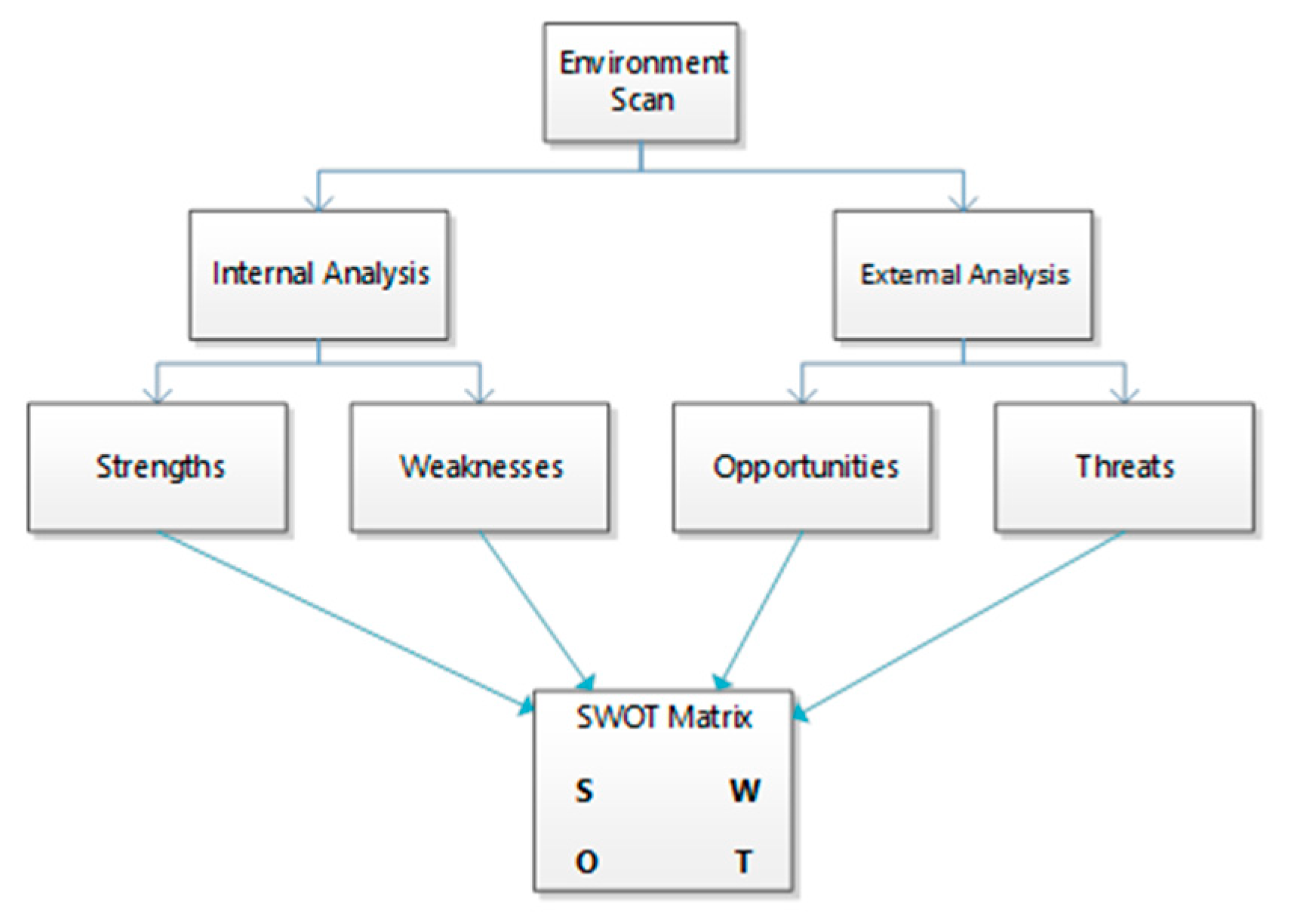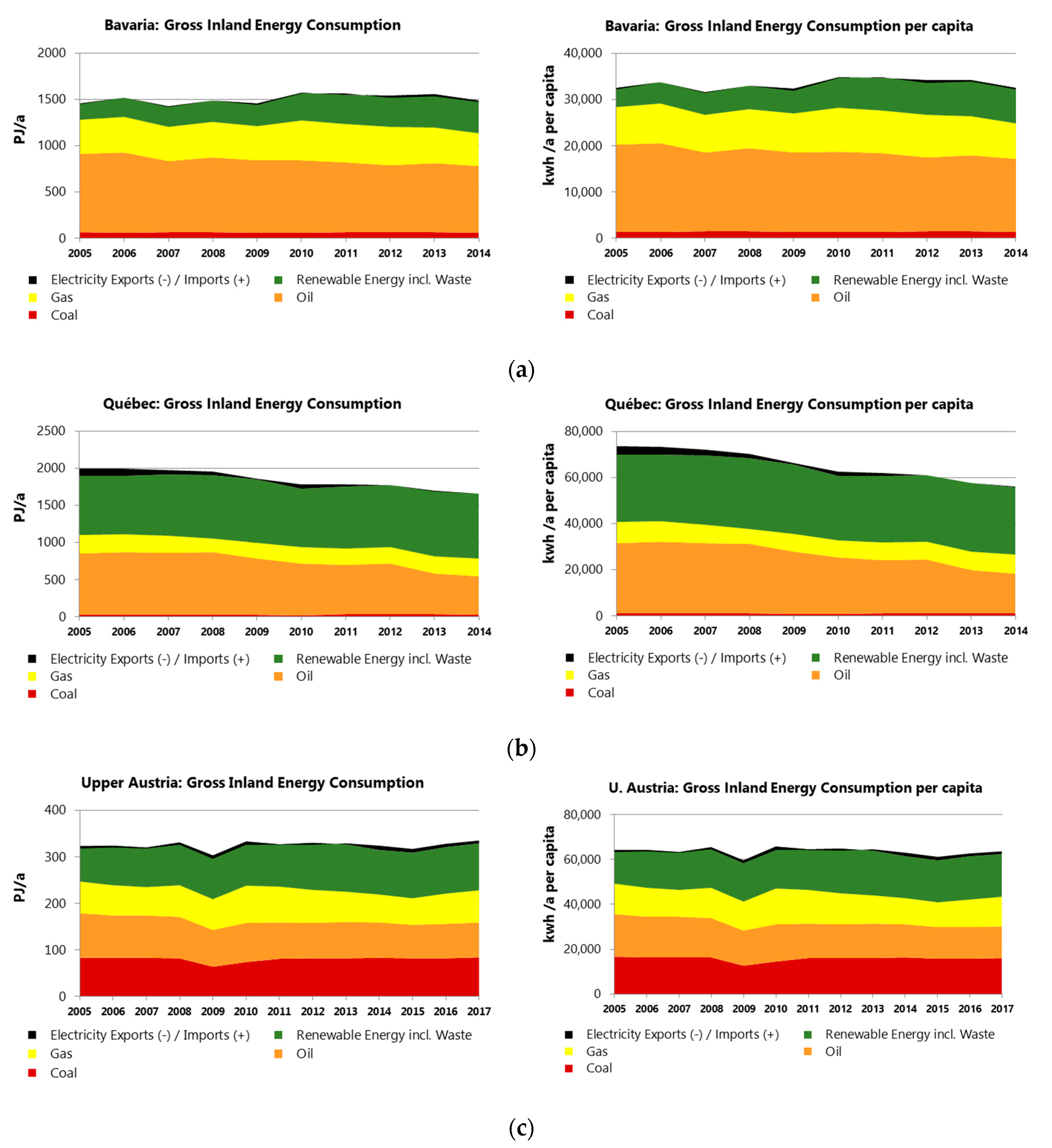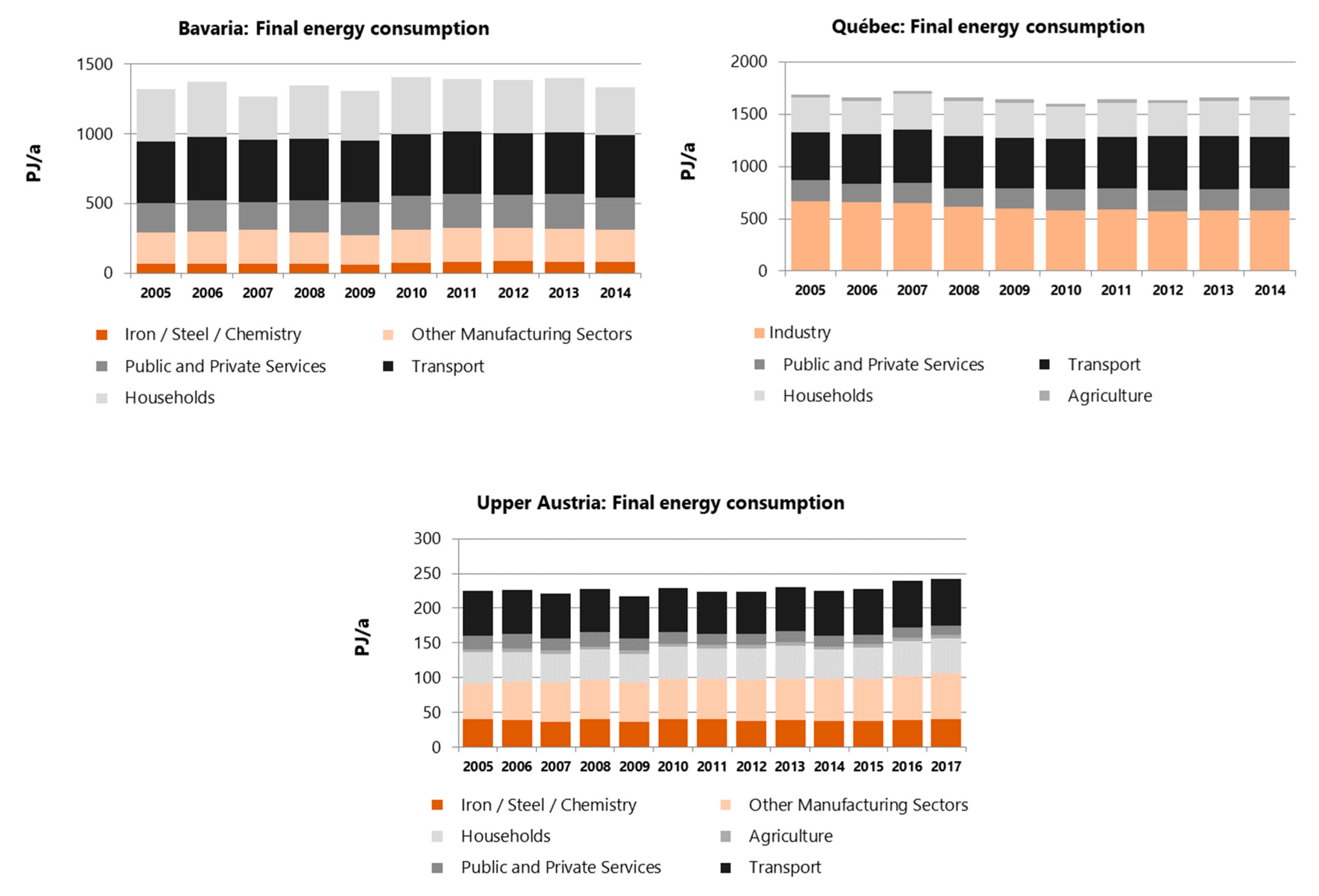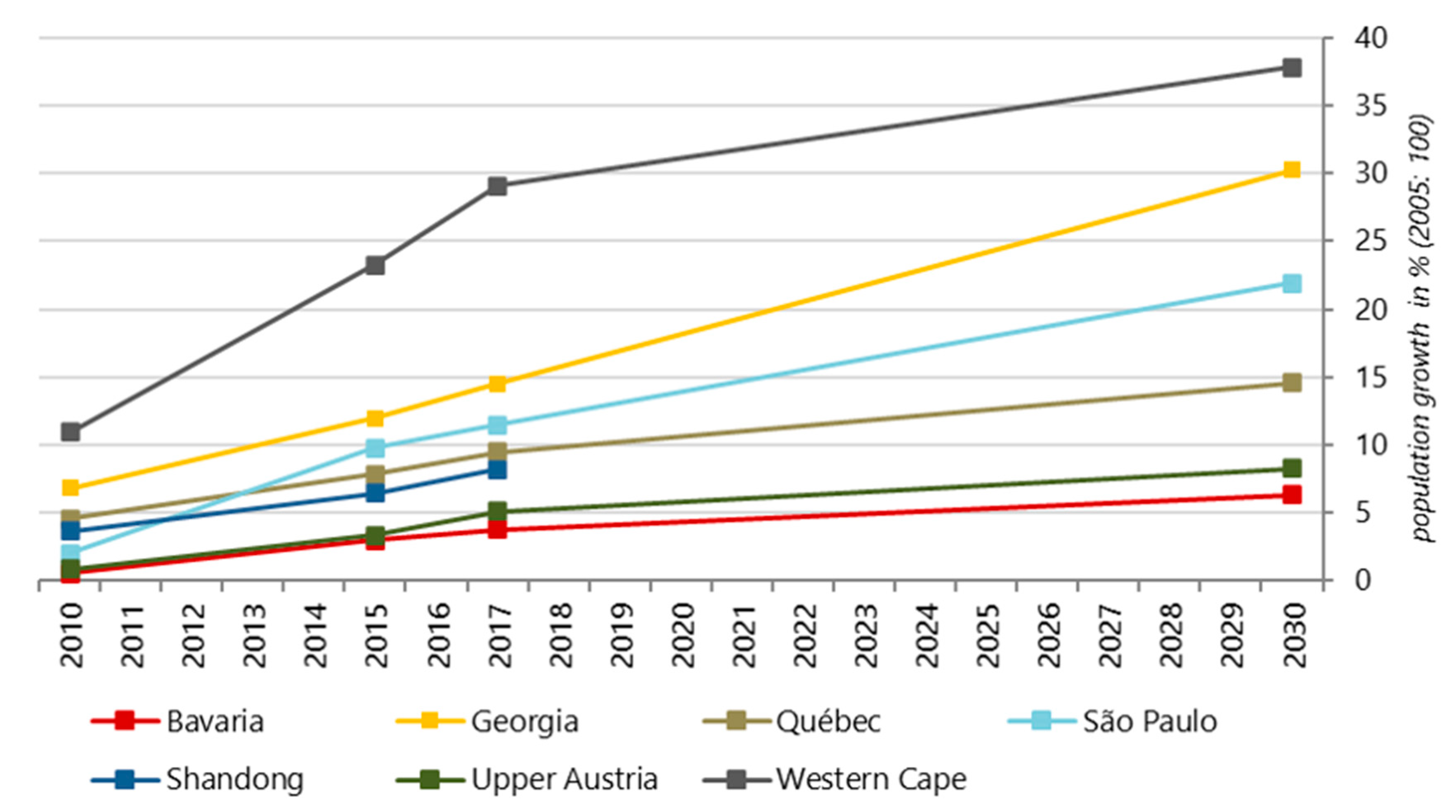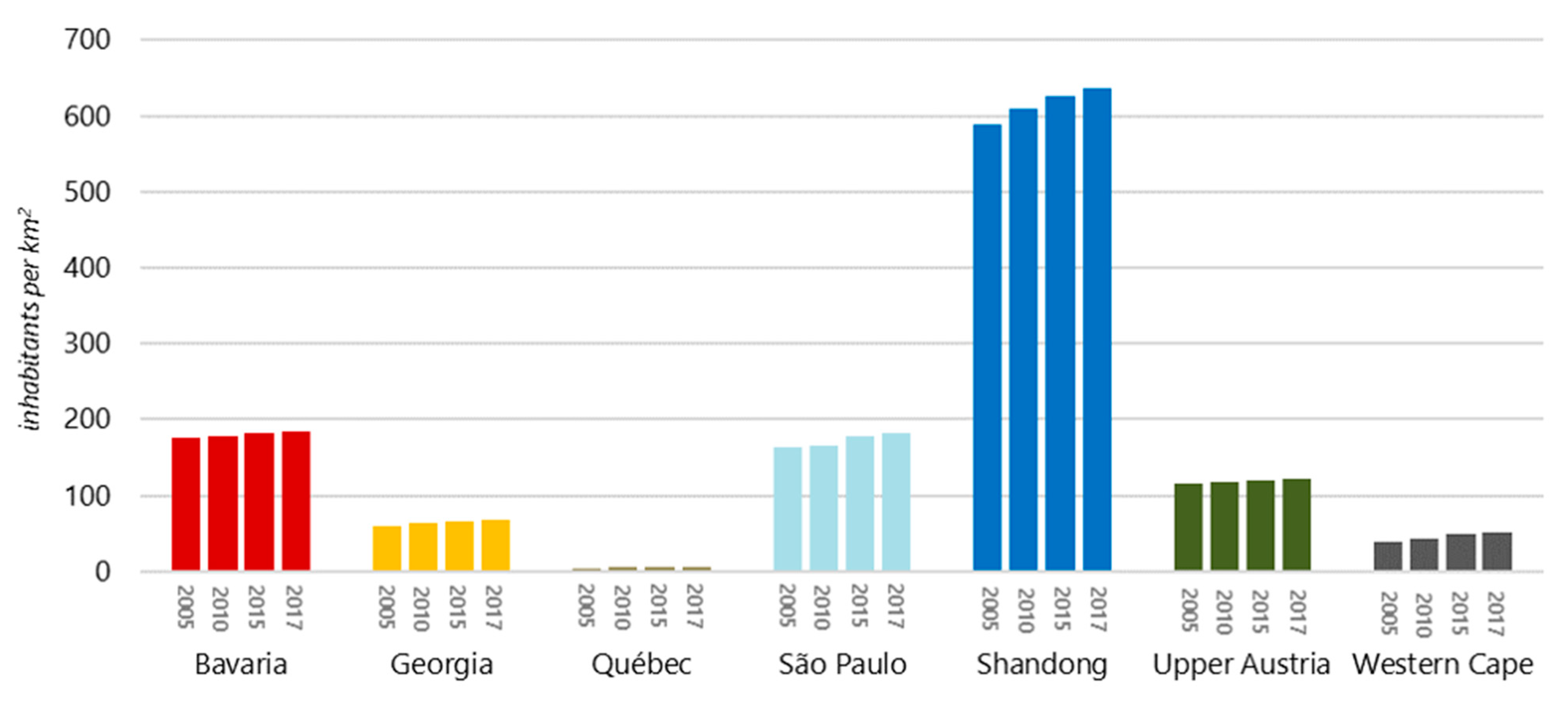1. Introduction
The transition of the world’s energy systems towards carbon-neutrality, with a significant increase of renewable energy, is a global trend with outstanding dynamics. Furthermore, the high cost and limited sources of fossil fuels, in addition to the necessity to diminish greenhouse gas emissions, have strengthened the role of renewable resources in energy-intensive economies. Renewable energy resources provide a vast potential to satisfy the world’s energy demand and are projected to have a significant share in the future global energy portfolio [
1]. The share of renewables in final energy consumption continues to increase globally with some technologies developing very fast [
2,
3,
4]. The average annual growth rate of modern renewables in final energy consumption over the past decade was 5.4% [
5]. Further, at the end of 2018, global renewable generation capacity totaled 2351 GW [
6], which implies an increase in renewable capacity of 7.9% during 2018.
Regions—here meaning subnational governance areas such as federal states or provinces—play a key role in the transformation of global energy systems [
7,
8]. Within the transition process, they face a variety of challenges via the structural changes brought by a low-carbon transition. Advancing the transition to a climate-neutral economy requires decarbonizing traditional production and consumption structures, implying investments in both energy efficiency and renewable energy. This transitioning to a climate-neutral energy system also involves effective multilevel governance practices, especially with respect to alignment among levels of government and stakeholder engagement [
9]. Regional governments have implemented a number of policies to boost the deployment of renewable energy. A closer look at these developments at the regional level allows us to identify the factors that influence the effectiveness of an energy system transformation.
In international cooperation, best practice exchanges at and across different governance levels, fields, and jurisdictions have become increasingly popular as a method to support and improve actions and outcomes, particularly related to climate action. Recent examples have included the United Nations Framework Convention on Climate Change (UNFCCC) supported “Talanoa Dialogue” in 2018 [
10,
11], which drew best practice examples from international, national, subnational, municipal, NGO and industry actors, the European Climate Initiative [
12], which works within the EU, the G20 Country Experiences on Climate and Energy [
13], which was derived by the G20 Climate Sustainability Working Group, the Vertical Integration and Learning for Low-Emission Development in Africa and Southeast Asia project [
14], which targets the subnational and municipal levels, or the International Council for Local Environmental Initiatives (ICLEI)-sponsored California–China Urban Climate Collaborative [
15], which is focused on cities.
The Regional Leaders’ Summit (RLS) is a multilateral political forum of seven partner regions: Bavaria (Germany), Georgia (USA), Quebec (Canada), São Paulo (Brazil), Shandong (China), Upper Austria (Austria) and the Western Cape (South Africa). The first meeting took place in 2002 and since then the heads of government of the RLS regions meet every two years in the framework of a political summit. During the summit meetings of the RLS regions, perspectives and strategies for a sustainable world under the guiding theme “Policy for Generations” are discussed [
16]. The seven RLS partner regions consider themselves to be leading players in their countries and continents with important technical, scientific and especially renewable energy resources. They choose to engage with one another as peers in the subnational context in the frame of the Regional Leaders Summit.
On April 12th, 2012, on the occasion of the sixth Regional Leaders Summit in São Paulo, the RLS partner regions adopted a Final Declaration which included the following commitment (Item 12):
‘‘In order to increase the proportion of renewable energy in the total energy consumption, as well as contribute to the security of energy supply and to promote renewable energy on a global scale, we invite our universities, research institutes, and industrial clusters to join forces in the formation of a network, centered on renewable energy and energy efficiency, so that innovations and new products will be developed to achieve these goals. This initiative will be led by the Government of the State of São Paulo until 2014. The intensification of the cooperation in research is necessary to implement these technologies in renewable energy sources and energy efficiency broadly and at a reduced cost.’’
As a result of this commitment, a scientific network of interdisciplinary energy researchers from all seven RLS partner regions was created in 2013. This is known as the RLS-Energy Network. The RLS-Energy Network was mandated to exchange on a research and innovation level, and began working to build up a network of key stakeholders in the energy research and innovation ecosystems in each of the RLS regions through annual workshops and exchanges. In 2016, the network was well established and created a Joint Roadmap, to specify future work to be conducted. This included, among other activities, the collection and analysis of data relevant for energy transitions at the regional level in the RLS regions. At the ninth RLS Conference in 2018, the heads of governments and representatives of the political level signed “The Québec Joint Declaration on Energy Transition” [
18,
19]. This declaration highlighted the political commitment at the regional level to an energy transition, with a goal for the regions to become leaders in energy transition by 2030. The document refers specifically to renewable energy and energy efficiency with the further aim of building a “new, strong, low-carbon economy’’. The declaration references not only the economy to be changed as a result of energy policies, but health and quality of life as well. The political leaders mandated the RLS-Energy Network to undertake work to support such a transition, identifying three main tasks: first, the sharing and exchange of expertise and information regarding renewable energy and energy efficiency, including expanding the dialogue around these topics [
19]; second, “identify opportunities for cooperation between the regions’’; and, third, “suggest actions energy leaders can take’’ before the 10th RLS Conference in 2020 [
19].
In order to fulfil these political mandates, the authors, who are part of the RLS-Energy Network, undertook a qualitative and descriptive study which aims at identifying and analyzing strengths, weaknesses, opportunities and threats (SWOT) for the role of renewable energy deployment in RLS regions’ energy transitions. This represented a first effort to identify, collect, aggregate, and analyze information about energy transitions across the seven regions. Although the analysis is specific to the seven RLS partner regions, the findings can be relevant to other areas, with appropriate calibration. Further, the paper highlights the complex energy systems’ structures in the RLS regions and supports energy-related decision making.
The article is structured as follows: First,
Section 2 will briefly comment on sustainable energy transitions and offer an overview about the RLS regions’ characteristics and energy landscapes. Second, we present our methodological approach, a SWOT analysis framework, in
Section 3. The main results are then described in
Section 4. The focus is placed on results which can be supported by empirical data and publicly available information from the RLS regions. The article discusses the results and their contribution to the analysis of regional energy transitions.
Section 5 concludes. In the recommendations we finally aim at offering findings for the political levels of the RLS regions.
3. Methodology
The above key data and outlines of the regions and their energy systems show that the population, geographic area, and economic, social and political characteristics of the RLS regions differ greatly. This naturally results in differences between the individual regional energy systems. Nevertheless, these systems face common challenges, namely how renewable energies can be integrated in regional energy policy. With this in mind, the study employs a SWOT analysis to highlight the role of renewable energy in the RLS regions’ energy transitions. The present analysis is not so much a question of defining singular steps, but of identifying common characteristics in the regional visions with regard to global transformation and thus further accelerating it. Through multilateral structure and multilevel governance within the RLS-Energy network, best practice approaches can be presented holistically and they can help to assess how regions can learn from each other.
A SWOT analysis is a type of planning method which is applied to assess the strengths (S), weaknesses (W), opportunities (O), and threats (T) associated with a project or a business venture [
73]. To undertake a complete SWOT analysis, it is necessary that the overall objective of the business venture or project is clearly defined, and internal and external factors that are advantageous and disadvantageous to accomplish that objective have to be evaluated.
SWOT analyses are often used as part of a strategic or business planning process, but can be suitable in understanding a situation and decision-making for all types of circumstances [
74,
75,
76]. It enables a state description to be determined by considering internal (strengths and weaknesses) and external factors (opportunities and threats). Based on this, the aim is to derive suitable measures to achieve the overall objective. Hence, the intention is to maximize the benefits from strengths and opportunities and minimize the losses from weaknesses and threats. For this purpose, combinations are searched for in a targeted manner, then it is asked which initiatives and measures can be derived from them:
Strengths: attributes of the project that imply a competitive advantage;
Weaknesses: attributes of the project that imply a competitive disadvantage;
Opportunities: factors and developments in the environment that can be beneficial;
Threats: factors and developments in the environment that could endanger the project or be disadvantageous.
The basis for a SWOT analysis is therefore a systematic process that allows for the space to identify factors that influence a strategy or a product. In addition to the collection of data and information, these are subjectively evaluated and logically ordered. This finally makes the presentation, interpretation, discussion and derivation of decisions more feasible. It builds upon the outcome of an environment scan [
77,
78] as displayed in
Figure 1.
It should be noted that the SWOT approach comprises no methods of analytically defining the weight of the factors or of evaluating the decision alternatives with regard to the factors [
79]. Recent studies link SWOT with the analytic hierarchical process concept in order to compare more detailed elements and provide a quantitative basis in the strategic planning process. The analytic hierarchical process concept is an effective decision-making technique primarily when subjectivity is present and it is appropriate problem-solving where the decision factors can be organized hierarchically and divided into sub-sections [
80].
The SWOT analysis technique has already been applied to energy research including renewable energy policy planning and review [
81,
82,
83,
84,
85,
86], which focus some similar questions to the present study, but in different regional frameworks. The objective in the SWOT analysis being undertaken for the RLS regions is to identify the role of renewable energy within the energy transitions envisaged by the RLS regions. Our analysis is based on a matrix. The starting point is a blank matrix, which is divided into four segments (strengths, weaknesses, opportunities, threats) as displayed in
Table 2.
Standard SWOT analysis methodology shows that filling in the sections can be done by interviews with experts, brainstorming, data analysis and literature reviews. We rely on the consultations with scientific and policy expert stakeholders from the seven partner regions through strategic conference calls and meetings [
87] of the RLS-Energy Network and the RLS Energy Network’s monitoring report [
88] which illustrates data and information on renewable energy with regard to the regulatory framework, status quos, potentials and research and development activities in the RLS regions. The consultations with scientific experts on regional energy transitions included requests for and the provision of regional data, review and completion of the SWOT matrix, expert presentations of energy transitions in the regions, and exchanges on the analysis throughout its development. In some cases policy stakeholders from the regions were engaged during dedicated science-policy interface meetings, while in others they were asked to provide data, review the SWOT matrix, and offer feedback on the development of the SWOT analysis.
6. Recommendations for Policymakers
The role of the RLS governments in guiding and managing regional energy transitions is highly important. The future will likely display an interesting and heterogeneous interaction between regional policies and their planned or already implemented future energy transitions. In addition, each region will be navigating these changes within the larger framework of their federal level legislation and policies, and the international commitments of their national governments. Simultaneously, the choices the regional level of government makes will be impacted by other actors in the sociotechnical system, including civil society actors, industry actors, and research and development and academia. Further, as members of the Regional Leaders Summit and the RLS-Energy Network, the RLS partner regions have the opportunity to exchange with their peers on their experiences with energy transition and share best practices, challenges, and lessons learned while preparing for further shifts.
Regional renewable energy targets and policies across the RLS partner regions vary extensively. On the one hand, the importance of climate action at the national and at the regional levels is increasingly translating into actions to support renewable energy. On the other hand, access to energy, energy security, and industrial development can be key reasons for renewable energy policy and actions. In all RLS partner regions, a focus on regional competitiveness, economic welfare and job creation often shapes policies. Among the political leaders of the RLS partner regions, there is broad agreement on these benefits and the promise brought forward by renewable energy.
The development towards renewable energies has made great progress in recent years, although support at the political level can still be expanded. Additional efforts must be made in order to achieve climate targets through the use of renewable energy, together with energy efficiency measures. In order to make even greater use of the potential of political support, it is essential that the policy measures focus on issues such as technology development, costs, financing, awareness raising, social acceptance and regulatory and institutional arrangements.
Above all, a combination of political measures is needed that are directly related to the use of renewable energy and its integration into the existing energy system. Direct political support for renewable energies in the electricity and end-consumer sectors can be target-oriented, since both account for a large share of final energy consumption and energy-related CO2 emissions.
In general, there is no single instrument that would automatically and equally meet the renewable energy targets in different regions. Political instruments must be defined in such a way that regional and national requirements are taken into account. It should be noted that a long-term approach to these policies generates planning security and trust, which in turn can trigger long-term growth. Hence, the dialogue on best-practice examples of energy policies within the RLS-Energy Network adds value to the RLS regions energy system planning and governance.
At the same time, political decision-makers should take into account developments in market conditions. This helps to remain competitive and continuously integrate renewables into the energy system. During the energy transition, it is essential to constantly consider its effects on society, public and private institutions and the economy in order to counteract obstructive developments in these segments. For this reason, energy system transformations require comprehensive and effective cooperation between all actors.
Competition between renewable energies and subsidized fossil fuels exists in many regions. It results that renewables should be given effective framework conditions for growth. Politicians should therefore ensure that renewables are offered the same framework conditions for further development, production and consumption as other technologies.
In addition, during the transformation process of the energy system, renewable energies must find a place in the daily lives of end users. This can be achieved by measures to promote behavioral changes, e.g., by raising awareness of energy options and use and building resilient livelihoods.
6.1. Conclusions and Recommendations for R&D
The RLS regions’ energy systems, driven by regional energy transitions, could potentially enable the realization of a strong integration of renewables and could cover partially distributed, decentralized energy systems with embedded energy storage, demand side management, and the application of smart technologies. It may also likely contain a large role for electric and renewable hydrogen mobility charged from regional renewable energy sources. Energy transitions are also intricately linked to efforts to enhance energy efficiency of buildings, industries and transportation.
Further progress in the utilization of renewable energy technologies may lead to even more economically efficient and ecologically effective alternatives to fossil energy production. The use of the existing potential (technical, economic) of renewables to meet the energy demand in the RLS regions can trigger economic growth and employment as well as investments in R&D.
6.2. Recommendations with Regard to Green Economy Issues
Alternative economic approaches, which change the current connection between economic growth and fossil energy consumption, are required in the long term to accomplish the necessary decarbonization of the society, regardless of growth limitations. The aim of the green economy is to support and form this transformation via technological, social and economic innovations. The possibilities for this in the RLS regions include many fields of action, such as the careful use of energy, raw materials and other resources, alternative consumer behavior up to and including sustainable mobility and infrastructure.
Hence, growth and employment should focus above all on those sectors that can make significant contributions to a green economy and the associated socioecological transformation. In order to achieve these objectives, a comprehensive green economy strategy should be drawn up and an implementation plan should be drawn up. Monitoring on the basis of reliable indicators (e.g., on the basis of existing OECD recommendations [
158]) should also allow regions to check whether the objectives of a comprehensive green economy strategy are being achieved.
In the regional RLS environmental technology industries, successful export initiatives should be continued. Regions should advocate for long-term, ambitious environmental and climate policy objectives should be defined at the national and international levels in order to create suitable framework conditions for companies in the environmental technology industry, while simultaneously developing their own long-term objectives where applicable.
Existing and proven promotional and educational instruments, especially in the field of research and development, should be continued to a greater extent in order to further promote the environmental economy and the environmental technology industries. In order to exploit the opportunities offered by digitization for a more resource-efficient, climate-friendly economy, corresponding research priorities should be set and innovations promoted.
In order to measure the efforts of research and policy, the generation of high-quality data on all relevant aspects of regional energy transitions is suggested. This is ongoing in all regions, and can be expanded to further support evidence-based policy making and the measurement of the regional energy transition across all RLS regions. Data collection is a critical component for tracking energy transitions and the impacts thereof across all aspects.
6.3. Recommendations with Regard to Social Acceptance
Bearing in mind that the realization of renewable energy projects depends to a large extent on their social acceptance, it is crucial to evaluate the social effects of setting up and expanding certain technologies of renewable energy as part of a wider energy transition. With regard to renewable energy project planning and development, societal acceptance should be taken in to account by the project developers, as well as related local and regional RLS government policy makers. A higher level of social acceptance can be triggered via participation of the regional community in organizational and development processes, or even through (co-)ownership [
152]. Further, policymakers should consider social acceptance as one of the crucial aspects in the predictableness of clean energy technology investments. Instruments for creating and further strengthening social acceptance include public campaigns, strategies for information and transparency, and direct support measures.
